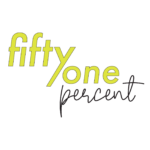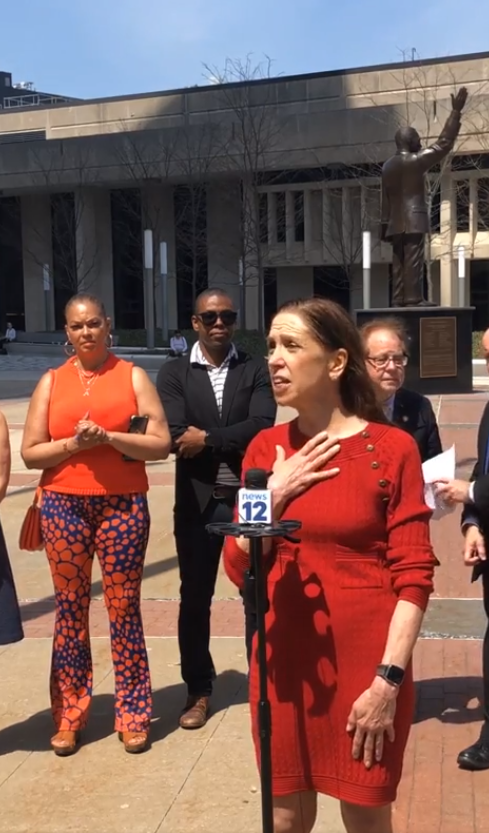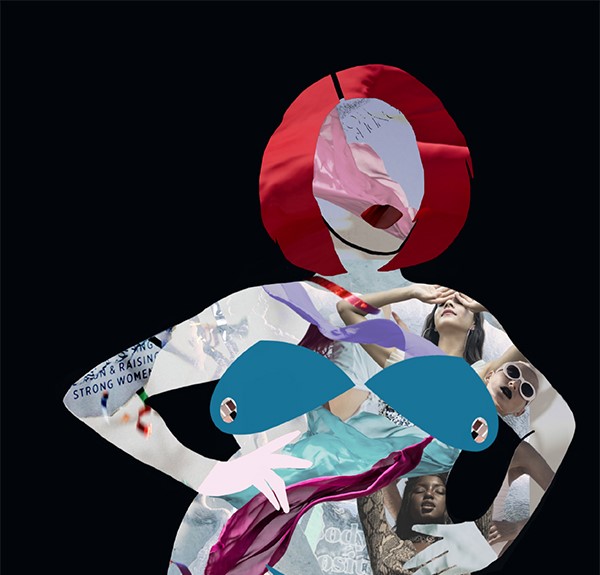
On this week’s 51%, we speak with professors Shani Orgad and Rosalind Gill about their new book, Confidence Culture, examining the prominence of confidence and self-help discourse in modern-day marketing, workplaces, relationships — and well, everywhere else. We also discuss a bill in the New York legislature that would give adult survivors of sexual assault the opportunity to look back and sue their abusers.
Guests: Dr. Shani Orgad and Dr. Rosalind Gill, authors of Confidence Culture
51% is a national production of WAMC Northeast Public Radio. It’s produced by Jesse King. Our executive producer is Dr. Alan Chartock, and our theme is “Lolita” by the Albany-based artist Girl Blue.
Follow Along
You’re listening to 51%, a WAMC production dedicated to women’s issues and experiences. Thanks for tuning in, I’m Jesse King.
Next week, we’re kicking off a series on women in business, which personally I’m pretty excited for — but before we do that, I want to talk about confidence. Oftentimes, when we talk about women in business, there’s a lot of focus on how women can better advocate for themselves and step up to the plate. We’re supposed to lean in, push ourselves into new territory, break the glass ceiling. To paraphrase some advice Kim Kardashian recently got a lot of heat for — because I can’t say the actual quote on the radio — we’re supposed to get up and work.
I feel that also applies to the way we look at ourselves in general, too. We’re frequently told to love ourselves, work on ourselves, feel comfortable in the skin we’re in — all great messages. But I have to be honest: it can be a lot of pressure, and sometimes I don’t. Sometimes I look at other go-getters and I’m like, “Man, I wish I could be like that.” Sometimes I don’t love the skin, or hair, or clothes that I’m in. It’s a lot of work being confident.
Our guests today have spent years looking into this phenomenon, which they call “confidence culture.” Dr. Shani Orgad is a professor of media and communications at the London School of Economics and Political Science, while Dr. Rosalind Gill teaches cultural and social analysis at the City University of London. Their new book — called Confidence Culture — interrogates the way we talk about confidence, and how, in some ways, self-help culture might hold us back.
Why is confidence discourse so prevalent right now?
Gill: Well, we talk about it in more depth in the book, and we kind of track it back through self-help literature and self-help culture and the expansion of that, and the way that that’s kind of taken off on social media. But we also sort of track it in terms of the global financial crisis, the recession, austerity, the kinds of messages that were more and more individualistic and, at least, very noticeable in the UK – for women to be to be thrifty, to make do and mend, [to] work on themselves, to use what resources they have to kind of hustle, I guess, in culture, most broadly. But we also talk about how it’s kind of related to the rise in visibility of feminism. From around sort of 2014, it’s been documented that feminism has really become much more visible as a kind of popular movement, and as a discourse across media. And we very much feel that this visibility of feminism has kind of allowed a space for these discourses of confidence to flourish. But of course, it’s a very specific kind of feminism. It’s a very individualistic feminism, it’s not a kind of collective, outward-facing, kind of “changing structures” kind of feminism. It’s very much a sort of inward looking, working on yourself to improve your position, kind of an emphasis.
How do you see confidence culture working? What are the different parts that come together to create this movement?
Gill: I mean, one of the things that was really, really striking to us was that we were working across different areas – like very different areas: the workplace, advertising, you know, “love your body” imagery, sex and relationships. In academic fields, these are spread quite widely, yet, what we’re encountering was the same messages, again and again. And it wasn’t just that they were the same broad messages, it’s actually the same words and phrases that were being used, repeatedly. You know, the sort of “Strike a pose,” “Feel comfortable in your own skin,” “Love yourself,” “Believe in yourself.” And it really felt as if this wasn’t just something that was happening in individual areas. It was kind of more than the sum of the parts.
Orgad: And so it works through discourse – but we also know that it’s very, very important as a visual regime. And again, as Ros mentioned, often through very similar visual imagery. So we identified what we call the “confidence pose,” which is, you know, the kind of Wonder Woman pose where you stand with your feet wide apart, hands on your hips, and so on. And this has been popularized by people like American social psychologist Amy Cuddy, who gave her most popular TED talk about power poses, where she literally shows Wonder Woman as the exemplar of this pose. What we noted is that, visually, this is was a really important signifier of confidence – across advertisements, we looked across women’s magazines, business journals, and reports. Again, in different domains and context, you will see the very same visual appearances that signified confidence.
We also realized that it’s not only discourse and not only kind of a visual regime, but confidence also, importantly, works through emotions, through the affective level. In other words, it’s not just about telling women certain things and encouraging them to change the way they think, or the way they look, crucially, but also fundamentally the way they feel. We identified particular aspects, particular emotions that are very much associated with confidence: resilience, positive thinking, gratitude. But crucially, it’s also about certain emotions that confidence is not aligned with. For instance, we found how the particular type of confidence that confidence culture encourages, which is very individualized and positive, also often comes and goes hand in hand with prohibiting anger, or prohibiting those feelings that are deemed supposedly “ugly” or “negative.” So don’t be bitter, don’t be angry – be confident.
And finally, we identify the way that confidence culture works also through practices – through not just things that you say, or not just even things that you feel, but also literally through things that you do. So again, it’s about how you write emails. In this context. Google launched their “Sorry, Not Sorry” plugin a few years ago, which was addressed, particularly to women, interestingly, not starting your email with, “I’m just writing to…,” “No worries if not,” all these kinds of edits that are particularly, again, addressed to women – because of this assumption that there is some kind of a deficit and this internal defect almost, or these self-inflicted wounds that we should somehow overcome. And partly, were encouraged to overcome through changing our practices, even through changing the way we breathe. We found a range of texts, to our astonishment, that are about how you should retrain, reeducate yourself, how to breathe, in order to become more assertive, to love yourself, and so on. So it’s ubiquitous, and that’s why we call it “culture,” across very distinct domains, but also across very different realms: the visual, the textual, the emotional, and also the lived practices that we are all kind of engaging in an everyday basis.
Your book mentions the popularity of confidence workshops or classes for women in the workplace – which surprised me, I don’t think that I have personally come across that yet. It kind of seems strange to me to have it company-sponsored. But can you tell me a little bit more about that?
Orgad: Yeah. And I think that is partly what we try to bring through the book, this kind of strangeness to it. To pause, to question things that have become so normalized and accepted. I’m really glad for you that you haven’t encountered it, we have encountered them ourselves. But also, since the book has been published, we’ve been receiving numerous emails and messages on social media from women, who say, “I was sent to one of these courses! Now I understand!” And evidently and importantly, beyond the anecdotal, these are also commercially viable programs that lots of workplaces are signing into. And, you know, sometimes they might not be explicitly called “confidence” – they are sometimes, for instance, under the guise of “leadership.” But then when you look at what they contain, they would be, often in very troublingly gendered ways, directed to encouraging women and trying to help women to build their confidence and so on. And I think it’s important for us to say that we do recognize that these are often well-meaning programs, in the same way that we recognize that the body positivity movement and “love your body” messages are and may be well meaning – and indeed may help women, individual women, to feel better about themselves, or to negotiate a pay raise, or to be more assertive in a meeting at work. We don’t want to dismiss this. But we are troubled by the way that these programs, confidence coaching and similar kind of programs, are very much individualizing both the problem and the responsibility for fixing the problem. Workplaces invest a lot of money in initiatives that ultimately individualize it to employees, and particularly to women employees, to find the problem, or their internal issues and psychological obstacles, as it were.
There are programs, for instance – and these are women-only programs, so in workplaces that are mixed workplaces, women-only programs are designed to help only those women in the work through a range of techniques that they’re being taught – it can include things like mindfulness and yoga, things that are to do with your physical kind of confidence, how you project confidence physically, through more kind of psychological work on yourself. Changing the ways you communicate, for instance, in written communication, and so on. One of the interesting things that we noticed during the pandemic is that we were both, like many other people, spending hours on Zoom. And one of the interesting things that flourished during the pandemic is “virtually confident” workshops, which were about teaching people – but again, especially women – how to project confidence on screen. It was found that women, much more than men, tend to touch themselves on screen, and so there were entire programs that Ros and I attended about making yourself aware and, again, how you use your voice and how you project confidence, how you occupy space on the screen, how you position yourself, what background you choose, and so on and so forth. So commercially, they’re viable, and they’re successful, which also suggests that it’s something that there isn’t just appetite for it, but a purchase to it. I don’t know, if you want to add, Ros.
Gill: I think I just wanted to add something about our own ambivalence. And it goes back to something that you said right at the start Jesse, about feeling that you receive a lot of these messages – and just to really, really kind of highlight that we are not critical of confidence messaging, and we’re not critical of women who find that messaging productive, helpful in their lives or, you know, beneficial for them to feel better. We confess to having cried at our fair share of Dove adverts and to having kind of adopted many of the confidence practices – both on ourselves, having done these courses, but also trying to encourage our students. We always encourage them, “Take up more space in the room, be bold when speaking at a conference, don’t write apologetically,” and everything. So just to really emphasize that our target isn’t confidence itself, and it isn’t the women that adopt those programs, but it’s what the culture does, and the way that it’s kind of been placed beyond debate. And it’s almost become like a cult in the sense that it’s kind of an article of faith that is unquestionable.
What would you say are the side effects of the culture? What does it mask over, and what is the effect on those in it?
Gill: I think the main things that it does are, first of all, it kind of places all the responsibility and all the blame on women themselves. So it treats it as if this is some kind of pathology, this is some kind of defect, it’s some kind of internal deficit. It’s something that women lack, and that they have to work on making up for. So it’s very blaming as a discourse. There’s an example in the book, The Confidence Code, which is, you know, a New York Times bestseller, a very celebrated book – but they talk about women scratching themselves, scratching themselves like babies do, and say that we need to put on the mittens so that we don’t scratch ourselves. Which we found to be so troubling, because it’s such a infantilizing metaphor. So there’s that whole kind of element of blame that is really problematic.
And then there’s the flip side of that, of like, what’s that doing when you kind of put all the responsibility for a lack of confidence, and for gender inequality, on women’s shoulders. It’s as if we’re doing this to ourselves, we put ourselves in this position, rather than looking at the structures and institutions and barriers that actually are in place that are preventing women and other oppressed and marginalized groups from actually making progress.
You mentioned earlier the kind of imagery you were noticing in the ads and campaigns you were studying. Did you notice a particular demographic or kind of women who were being targeted to be more confident, or who were most showcased and represented as “confident” in these ads?
Gill: We’ve tried to be really, really attentive to differences across the entire book, and we hope that the book offers a really intersectional feminist analysis of what we’re seeing. So we’ve looked across age, we’ve looked across race and ethnicity, we’ve looked across disability and sexuality. I think what we’ve really tried to problematize, and it comes out most visibly in relation to the advertising, is a kind of faux diversity, in a way, a sort of hollowing out of diversity. At first, we were kind of hopeful that this kind of advertising was going to actually open up space for many more different kinds of women to be shown, who aren’t usually the kind of white, middle class, cisgender, able-bodied, women that dominate the visual habitat that we all live in. We did see more diversity, but then we immediately saw that being somehow undercut or undermined with a kind of “one size fits all.” So this sort of sense that, “Well, whatever the problem, whoever the group, there’s just one solution” – and it’s to be more confident, confidence training programs, something like that. So it’s a kind of double-move of recognizing diversity, only to then kind of say, “Well, it doesn’t matter.”
So what do we do? I mean, how can we help women feel more confident without making them feel like there’s pressure on them? Or that there’s something wrong with them?
Orgad: Yeah, I think it’s a really good question. And I would really just reiterate what was said earlier, that we are not against confidence, and we want women to thrive and feel safer and happier and more confident. But we feel really strongly that, at the same time, we need (and by we, we mean not just with women, but crucially as a society) to really think critically about how not just to invest in demanding and encouraging and exhorting women to be more confident and fix the problem as it were themselves, but to think and nourish structural thinking. And so we ended the book, in our conclusion, we call it “Beyond Confidence.” And we’re trying to look at examples that perhaps are not entirely outside confidence or against confidence –because again, we are not ourselves against confidence – but that do introduce those things that, as you mentioned before, Jesse, that confidence culture masks and perhaps minimizes or marginalizes. And we talked about what we call “confidence climate” – how can we think about nurturing and building a climate that enables and allows women and everybody and other disempowered groups to feel safer and feel more confident, rather than putting again the onus on individuals to do that work? In this context we bring Lizzo as an interesting example, because she’s kind of the self-confidence queen, but at the same time, Lizzo is a really interesting kind of person and persona to think through about what we can do differently. Because she foregrounds, for instance, interdependence, she foregrounds the ways in which she herself, to become confident, is dependent on her family, on her network of friends, on the community who travels with her on her tour. So one way, for instance, that we would want to think about building a climate of confidence is a climate that encourages our dependence on each other, and doesn’t deem being dependent on somebody abhorrent or ugly or undesirable. The [current] confidence culture is not about needing help from anybody else, it’s about you caring for yourself, because nobody else will. So these are kind of ways that we feel that should come, and we would hope would come, alongside the more kind of individual work that perhaps women can do, or do do – and we would have liked to see workplaces investing more in structural changes that create places and workplaces that are confident workplaces, where employees can thrive as confident beings, rather than sending them on these courses that keep telling them the problem is you, you fix it.
Drs. Shani Orgad and Rosalind Gill are the authors of Confidence Culture, out now on Duke University Press. Shani and Rosalind, thanks so much for taking the time.
We’re gonna switch gears before we head out to recognize Sexual Assault Awareness Month – and a warning to those who may be sensitive to the subject. On Thursday, New York state lawmakers joined survivors in Westchester County to call attention to a bill that would give some adult survivors the opportunity to sue their abusers in court.
The Adult Survivors Act is similar to the Child Victims Act passed by the legislature in 2019, which gave survivors of childhood sexual abuse a one-year lookback window to sue their abusers, in some cases long after the state’s statute of limitations expired. The one-year window was ultimately extended another year due to the coronavirus pandemic. This time, the Adult Survivors Act would open up that opportunity to those who were 18 years or older at the time of their abuse. The bill was passed by the State Senate last year, but it has so far stalled in the Assembly.
It was a blustery Thursday in New York’s Hudson Valley, but advocates with the victims assistance nonprofit Safe Horizon still gathered outside the Westchester County Court in White Plains to push for the bill’s passage.
State Senator Shelly Mayer, a Democrat from the 37th District, is a co-sponsor of the bill.
“This is so basic to our system of laws. We’re not talking about criminal penalties here, we’re talking about the opportunity to confront your accuser and make a civil claim for damages,” says Mayer. “And that is what our systems of laws is based on. The equality of opportunity to assert your claim.”
Safe Horizon Vice President of Government Affairs Michael Polenberg says more than 10,000 lawsuits were filed as a result of the Child Victims Act by the time its lookback window closed last August. Four of the state’s eight Roman Catholic dioceses filed for bankruptcy, as did the Boy Scouts of America, at least partly due to a large number of lawsuits regarding sexual abuse.
In 2019, lawmakers also expanded the civil and criminal statute of limitations for several felony sex offenses in the state. The criminal statute of limitations for second and third-degree rape increased from five years to 20 and 10 years, respectively, and Polenburg says the civil statute now stands at 20 years for both — but he notes those changes were made proactively, not retroactively.
“Meaning certain survivors who were abused before 2019 still only have a few years to file a civil lawsuit,” he adds.
Polenberg says that, as child victims have been given the chance to look back, so should adults. For many survivors, coming to terms with what they went through can take years, even decades.
Donna Hylton, activist and author of the memoir, A Little Piece of Light, says she’s been surviving trauma and sexual abuse for the majority of her life – something she didn’t really come to terms with until after her incarceration at age 20. Hylton says she was incarcerated for 27 years, and that people often misunderstand the sheer number of adult survivors in state prisons alone.
“That 85 percent that we’ve been told for so long, of women, young women, and gender-expansive people that are in the system, that have been abused, is wrong. It’s more like 97 percent. Closer to 98 percent. Why? Because people still don’t talk. Why? Because people still don’t listen,” says Hylton.

Assemblymember Amy Paulin, a Democrat from the 88th District, says she became a survivor at age 14, and it took years for her to say it out loud.
“I buried it, it was something I was embarrassed about, it was something that I never told anyone about — and I don’t know that that would have been different if I was four years older,” says Paulin. “If you’re 17, you’re a minor, you’re 18 and all of sudden you’re not. And I don’t know what shifts or changes in a young woman’s mind…not that much. So we have not addressed the remedies for so many young women who likely have not or did not even come to grips with their own sexual assault. So this is a very important bill.”
“For many years, it was the State Assembly that moved the Child Victims Act forward. We’re now in the situation where it’s the Senate who’s moving on the Adult Survivors Act — they passed it last year unanimously, everyone voted in support. This year, the bill has already moved through the Judiciary Committee and the Finance Committee, and it’s now heading to the floor, and it’s the Assembly where the bill seems to be stuck,” adds Polenberg. “So we’re hopeful that, with the support of the assemblymembers here today, that we can finally move this bill forward this year.”
Fellow Democratic State Assemblymembers Chris Burdick and Tom Abinanti joined Paulin at the press conference Thursday. New York’s legislative session wraps on June 2.
Safe Horizon has operated a network of New York City programs helping survivors of sexual assault, domestic violence, human trafficking, homelessness and more since 1978. The nonprofit says it responds to roughly 250,000 New Yorkers a year who have experienced violence or abuse.
51% is a national production of WAMC Northeast Public Radio. It’s produced by Jesse King. Our executive producer is Dr. Alan Chartock, and our theme is “Lolita” by the Albany-based artist Girl Blue.

